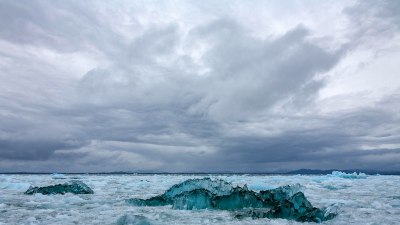What Causes Ice Storms to Be So Destructive
Explore the causes and impacts of ice storms and why they can be so devastating.

Ice storms are one of nature's most beautiful yet deadly weather phenomena. They can transform everyday landscapes into stunning winter wonderlands, but they also bring significant destruction. Understanding the causes and impacts of ice storms is crucial in appreciating their destructiveness. Ice storms occur when freezing rain falls, coating everything in a thick layer of ice. This article will delve into the science behind ice storms, the conditions required for their formation, and the resulting destruction they can cause.
What Is an Ice Storm?
An ice storm is defined as a type of winter storm that results in the accumulation of at least 0.25 inches (6.35 mm) of ice on surfaces. This accumulation of ice can create hazardous conditions, including downed power lines, fallen trees, and dangerous roadways. The formation of ice storms is closely tied to temperature patterns, atmospheric conditions, and the trajectory of storm systems.
How Ice Storms Form
The key factor in the formation of ice storms is the presence of a warm layer of air above a colder surface. This scenario often occurs in mid-latitude regions during the winter. When warm, moist air from the south rises and overflows a cold air mass, the raindrops falling from the warm air cool as they descend through the colder air mass closer to the ground. If the temperature is below freezing at ground level, these raindrops turn into freezing rain, which falls and coats surfaces like roads, trees, and power lines with ice.
Ideal Conditions for Ice Storms
Several meteorological conditions are ideal for the formation of ice storms. These include warm air masses, a significant drop in temperature close to the surface, and high humidity levels. The collisions of these varying air masses often occur along warm fronts, cold fronts, or occluded fronts. During the winter, the contrast between warmer southern air and colder northern air is especially pronounced, creating an environment ripe for ice storm development.
The Ingredients of Ice Storms
Primary ingredients necessary to create an ice storm involve atmospheric pressure variations, the right temperature gradient, and moisture-rich air. As storms develop, meteorologists monitor factors such as the location of the polar jet stream, which can influence the weather patterns conducive to freezing rain. The shapes and movements of pressure systems can either amplify or diminish the likelihood of an ice storm.
The Destructive Forces of Ice Storms
When ice storms occur, they bring a range of destructive forces that can devastate infrastructure and landscapes. The accumulation of ice on tree branches can become incredibly heavy, leading to broken limbs and fallen trees. This can cause power outages, as power lines are knocked down. Additionally, walking, driving, and traveling become hazardous due to slick surfaces. With people unable to access basic essentials, the widespread impacts of ice storms are often felt for extended periods.
Public Safety Concerns
Ice storms pose substantial threats to public safety. Travel during an ice storm is one of the most dangerous activities, as roads can quickly become icy and treacherous. Many accidents occur as vehicles lose traction, leading to collisions. Furthermore, falling trees and downed power lines present risks to pedestrians and drivers. Emergency services report increased call volumes due to incidents resulting from ice storms, placing added pressure on first responders.
Economic Impacts of Ice Storms
The economic ramifications of ice storms can be extensive. Costs arise from property damage, lost productivity, and the need for emergency response. Utilities spend billions of dollars each year repairing damage caused by ice storms, as restoring power to affected areas can take days or even weeks. Additionally, businesses often face shutdowns, resulting in lost revenue and wages for employees.
Long-Term Environmental Effects
Ice storms can have long-lasting effects on the environment. When trees are damaged or killed due to ice accumulation, it disrupts local ecosystems. The loss of trees leads to changes in wildlife habitats, as animals rely on forested areas for shelter and food. Soil erosion may increase due to the uprooting of trees, leading to potential flooding in areas where soil stability is compromised.
Mitigation and Preparedness
Preparedness is key in mitigating the impacts of ice storms. Authorities often issue warnings well in advance, giving communities time to prepare and adjust their plans accordingly. Residents are encouraged to have emergency kits, stock up on necessities, and stay informed about current weather conditions. Additionally, local governments invest in winter maintenance such as salting roads to minimize ice accumulation and ensure safer travel conditions.
Advancements in Weather Prediction
As technology advances, the ability to predict ice storms has significantly improved. Meteorologists utilize advanced weather models and satellite imagery to assess potential storm development and track weather systems. Accurate forecasts empower communities to take preventive measures, better protecting lives and property from the destructive forces of ice storms.
Coping with Ice Storm Aftermath
After an ice storm strikes, coping with the aftermath requires coordinated efforts among utility companies, emergency responders, and local governments. Power restoration efforts are often the top priority, as downed lines can leave entire neighborhoods without electricity. Community resources such as shelters may be set up for those displaced by storm damage, providing warmth and safety until conditions improve.
In conclusion, ice storms are destructive weather events that can lead to widespread impacts on safety, infrastructure, and the environment. Understanding their formation and the conditions that lead to such storms is essential in preparing for and mitigating the effects. As we observe changes in weather patterns and extreme weather events, staying informed and adequately prepared remains vital in reducing the dangers associated with ice storms.











